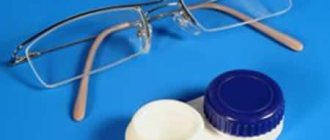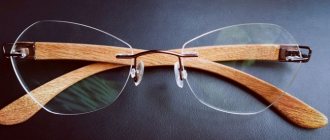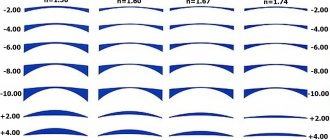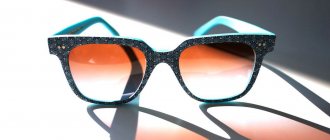What are photochromic glasses: how they work
Such accessories use lenses with photochromic substances included in them. When exposed to UV rays, photochromic lenses darken and return to their original color indoors. That's why they are also called chameleons
.
The degree of darkening of chameleon glasses depends on the intensity of sunlight - the more sunlight there is, the more the photochromes change their molecular structure. The dimming ranges are divided into three groups according to intensity:
● 10-55% - low dimming;
● 15-65% - medium darkening;
● 30-85% - the highest darkness; such lenses are necessary for people with increased sensitivity to light.
Chameleon glasses for welders
If all the previous types of glasses are only advisory, then for welders they are mandatory.
Goggles protect not only the eyes - during such work, sparks can damage the respiratory system, so these goggles are a one-piece mask that completely covers the face.
For welders themselves, chameleon glasses are automatically darkened to the extent necessary for the given mode of work being carried out. Such glasses are a complex electronic structure. When turned off, the glass acts like a regular sun filter; it begins to act when it is turned on.
Such glasses always have a maximum degree of darkening, over 80%. They use fireproof glass in brown and gray colors, and the light filter provides shading up to 16 DIN.
The filter in the glasses itself is multi-layered, consisting of polarizing films, with layers of liquid crystal structures between them. Exposure of them to the electromagnetic field generated during welding operations leads to a change in the transparency of the entire glass.
Sources used:
- Kuropatkina, M.V. Treatment of eye diseases: Vision correction. Optics / M.V. Kuropatkina. - M.: Ripol Classic, 2010.
- Muldashev, E.R. Complicated glaucoma / E.R. Muldashev, G.G. Kornilaeva, V.U. Galimova. - M.: Neva, 2005.
- Modern ophthalmology. Guide / Edited by V.F. Danilicheva. - M.: Peter, 2009.
- “Eye Microsurgery” named after Academician S.N. Fedorov" of the Ministry of Health of the Russian Federation
Who are photochromic lenses recommended for?
Chameleons without diopters are suitable for people involved in tourism or skiing
. Since the terrain and lighting of mountain ranges are constantly changing, quick adjustment of the eyes is necessary. With photochromic lenses it is painless, and image clarity does not suffer during a sharp transition from a darker area to a sunny one and vice versa.
Chameleons will also be a useful acquisition for cyclists
. Fitting tightly to the face, they will protect the eyes not only from bright light, but also from dust and insects.
Chameleon glasses without diopters are also used by drivers
. The darkness of the lenses in this segment is 50%. And when photochromic lenses are coated with a polarizing anti-reflective coating, the optics provide even greater safety on the road. The driver's eyes will be protected from the shine of wet asphalt, objects that glow in the dark, and other blinding interference at any time of the day.
Ophthalmologists recommend corrective photochromic glasses to all patients, but especially in such cases:
● recent eye surgery;
● presence of retinal pathologies;
● farsightedness in old age;
● predisposition to cataracts in adulthood;
● high photosensitivity.
Types of photochromic lenses for glasses with diopters
Photochromic lenses with diopters are needed to obtain sun protection with a corrective effect. Corrective optics are divided into:
● traditional;
● monofocal;
● progressive;
● aspherical.
Monofocal and traditional lenses are prescribed for farsightedness and myopia
. A mild form of astigmatism requires wearing aspherical lenses. For age-related changes in vision, doctors recommend the progressive type.
Rating of photochromic lenses for glasses with diopters
Photochromic lenses developed using the following technologies are considered the best:
1. Transitions.
Such lenses transmit light in full indoors. In daylight outside, the windows quickly darken.
2. Serengeti Polar.
Their main feature is the polarizing coating. Absorbs up to 95% of harmful blue radiation and up to 100% of ultraviolet radiation. This is the most optimal option for corrective lenses.
3. SunSensors.
Photochromes are embedded in a liquid polymer rather than applied to the finished lens by sputtering. Light absorption capacity reaches 100%. Lenses made using this technology are the most popular in Russia.
The most accurate and easiest way to test your glasses for UV protection
It's best to test your glasses for their ability to filter UV rays when you buy them. In this case, all you need to do is ask a consultant for this service. In serious stores there is always a special device - a spectrometer, which, as a result of checking the glasses, shows on its screen the maximum length of ultraviolet waves that they are able to block.
In addition, if there is a UV400 mark on the glasses or in the description, it would not be superfluous to check whether they really have the declared level of protection. Some manufacturers of sunglasses, especially when it comes to non-original copies and little-known cheap brands, may deliberately exaggerate their merits to make them more attractive for purchase.
You may be very surprised if you decide to test your glasses for ultraviolet light. In some products (and not only cheap ones), there may be no protection at all or it will be minimal. In others, 95% protection is most often found, which should correspond to the UV380 marking - a completely safe option for the eyes, but it falls a little short of the ideal (filtration of UV waves with a length of 400 nm).
In any case, given the simplicity and speed of verification, it is worth taking advantage of this opportunity to make sure that the purchased accessory meets the properties declared by the manufacturer, as well as your requirements and hopes.
Which photochromic glasses to choose
Chameleons not only with sun protection, but also with corrective function should be selected after consultation with an ophthalmologist. If you need glasses without prescriptions, you should focus on your own style and lifestyle. For example, polarized sunglasses are suitable for cyclists and motorists, while sports chameleons are suitable for climbers. You should check the lenses before purchasing - dark edges mean they actually contain photochromes.
offers customers products from companies whose reputation has been tested by time - Carl Zeiss and Rodenstock
. Zeiss lenses are made using unique molecules that instantly change the color of the glass when exposed to UV rays. And the optics from Rodenstock, in addition to darkening up to 85%, provide eye protection against blue light. The lenses of this brand are additionally coated with protective layers - strengthening, anti-reflective, water-repellent.
Steps
Buying original glasses
- Pay attention to the label and logo.
On branded glasses, logos are usually placed on the lenses, temples or the inside of them, and the size, color and model are also indicated on them. Any seemingly insignificant error may indicate that your glasses are fake. Typos in brand names (for example, “Guci” instead of “Gucci”) indicate that the glasses are fake. Before purchasing, visit the manufacturer's website and check the labeling and logo. This will help you when making a transaction directly.
Pay attention to the model markings.
The model number is the same worldwide, regardless of whether you bought your glasses online or in a store. Go to the manufacturer's website to compare the sunglasses model number. As a rule, the model marking can be found on the frame. Counterfeit glasses may have numbers that are not listed on the manufacturer's website.
Buy glasses only from a trusted seller.
Genuine glasses are usually sold at official representative offices of the company. On the street, most likely, they will sell you a fake. You are dealing with a fake if the price is too low and suspicious. Stay away from sites that do not allow returns and where you cannot find contact details (such as phone number, email address, etc.).
- China is the birthplace of most counterfeit items. Be careful when purchasing products made in China.
- When purchasing goods online, you need to check the traffic to this site and customer reviews.
- Websites selling original products must have a certificate of authenticity.
- The glasses you buy must be made with high quality and have an impeccable appearance.
- Recognize keywords.
Words such as “high quality”, “cosmetic”, “replica”, “sample” often indicate that the glasses are counterfeit. Notice if the seller uses one of these phrases. In addition, such glasses can easily break and do not protect your eyes from ultraviolet rays.
Listen to your intuition.
There are many signs of authenticity of glasses. Use common sense and intuition. Find out more information about the company you are purchasing glasses from. There are really favorable conditions for purchasing original glasses. If the price is really low, study all the characteristics before making a purchase.
Check your glasses
- Check the packaging.
Genuine brand glasses are sold in original packaging. A label with a barcode and information about the manufacturer must be placed at the bottom of the box. Quality certificates and a warranty card must also be included.
Inspect the packaging carefully.
Glasses must be supplied in a branded case. The brand logo must be located on the case. The cover must be in perfect condition, without scuffs. The color and shape of the cover may vary depending on the year of release of the collection.
Check lenses and nose pads.
In authentic glasses, the logo is often located on the right lens. It must be clear and understandable. Nose pads should be located on the frame in the nose area. Some glasses also have the logo printed on the nose pads.
Check the glasses for compliance with all parameters.
The logo, serial number and model type must be printed on the glasses. The numbers on the label and box must match the number of the glasses. The logos on the glasses, case and label must be identical. Your glasses may very well be fake if you notice any inconsistencies or typos.
Pay attention to quality.
Glasses and their packaging must be of high quality. Glasses that are flimsy or too light may be fake. New original glasses are usually sold in beautiful packaging with tags and a case. The fake is sold in a low quality box or soft packaging.
- It is especially important to check the quality of the product if you are buying used glasses, as they are often sold without the original packaging.
Return of fake glasses
- Contact the seller.
Be sure to inform the seller or online store about the counterfeit you discovered and your desire to get your money back. We hope that the seller will meet you halfway and fulfill his obligations. If he doesn't do this, threaten to file a complaint with the bank. This may force him to meet you halfway.
What are we afraid of when buying glasses from Ketayan? That's right, lack of nominal UV protection. And if the polarization can be checked at home, then with these UVA, UVB - there’s no way (at least I don’t know how:(. So, if aliens have not suddenly given you an amazing gift, like the hero of Kaganov’s “EAR”, go ahead - to any optical network. I, at random, called Ochkarik. It turned out that they “for free” (this happens) check any of your glasses for compliance with the declared UVA, UVB values.
One of these days I’ll go test the following nominees:
UPD. They arrived yesterday. Glasses get second place in my personal ranking of successful purchases after SKU 14174 illus. The glass is good, fits like a glove - there wasn’t a moment of discomfort at all. This is exactly what I will wear in the car. I did not check the visual sensations from “looking at me”. Those. design is the last thing I looked at. However, they are molded with a curve to the face. Summary: I recommend it. I would buy myself another one. *** SKU 23166
UPD. Received. Not delighted. Soft touch plastic, but it feels like broken SKU 21765. One delight - a lanyard for glasses, very convenient fastenings - this is the first time I've seen something like this. Summary: I wouldn't buy another one for myself.
***SKU 48879
UPD. Received. The plastic is some of the worst I've ever seen. Slightly worn frame (I ordered two at once - both were like this). In general they are made very poorly. The most protective glass (iris) only “slightly blocks out” light. I wonder what the device will show... Summary: I had much higher hopes for them. I wouldn't buy another one for myself. Changing the glass, I broke the darling. Be careful, or better yet, don't buy at all...
*** SKU 14174
I have it. Excellent quality, one of my best purchases. I’ve already managed to hold a lot of glasses in my hands :) I’ll buy a couple more in reserve. For the street - not very good (the lens is small, a lot of light comes in from outside. For a car - a fairy tale. Polarization is present. There are shock absorbers on the earbuds. I’m just shocked by the quality, despite some ridiculous brand :) *** SKU 22864
I have it. The shape is not ice - straight, without going around the contour of the face, but it would be a shame to throw it away :) *** SKU 22856
I have it. See previous point. *** SKU 68361
I have it. There are doubts about the viability, because they are made of the same plastic as the last nominee (see below). No matter how they break tomorrow...
*** SKU 21765
But this nominee will not go anywhere, because it broke two days after the start of use. The seal above the left lens cracked due to a slight extension force. Possessed it :)
PS I’ll write back immediately after testing. ******************* I am unsubscribing. I was at Ochkarika on Komsomolskaya (Moscow department store). I checked everything that was there. Total. They have a fairly simple device, nothing fancy. Three indicators on the display - light delay level, ultraviolet delay level, surface specularity level (?). ALL DARK GLASSES IN OUR CHINESE HAVE A 100% UV RETENTION LEVEL. True, the device did not specify which ones (what wavelength), but we will assume that it is those that are the most dangerous (that is, with a wavelength of 400 nm and higher):) Otherwise, only transparent and yellow ones allowed UV to pass through. But as far as I remember, they ride in yellow ones at night, and transparent ones are not for sunny weather...
In general, there is nothing to add, except that I broke the S-4 I had been waiting for so long on the same day - when inserting the lens, one “point” cracked.
Instead of them, I will order this for myself now
Why do people usually buy sunglasses? Of course, they can be considered as a stylish accessory, but their main and original function is to protect your eyes from the harmful effects of sunlight. In this case, the most important parameters are protection from the UV spectrum of sunlight and polarization (screening out intense light and glare).
We have already written about how to check glasses for polarization. Now it’s time to study existing ways to test sunglasses for ultraviolet radiation. Yes, don’t be surprised - this check also needs to be performed, since the assumption that UV protection should be in all glasses by definition (they are sunglasses!) is not correct.











